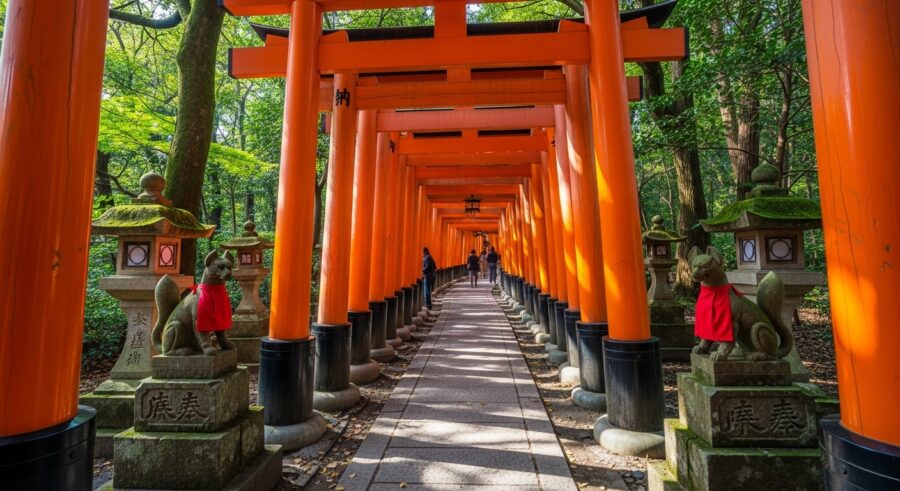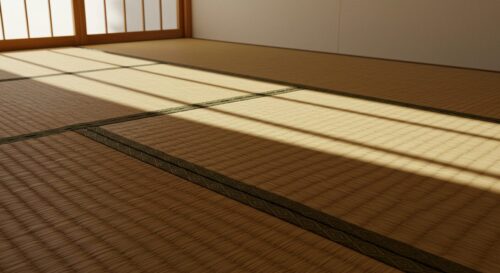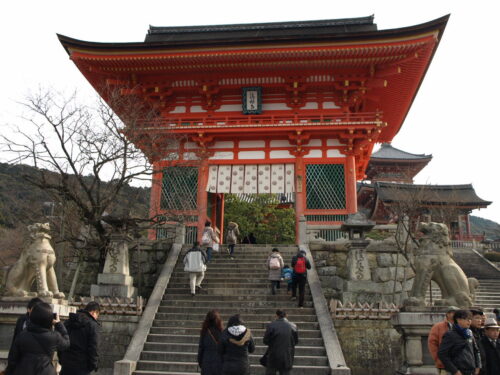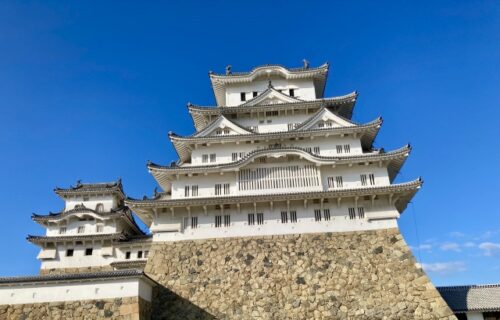Discover the Ancient Architecture of Fushimi Inari Taisha in Kyoto: Historic Buildings Guide.
2025年10月22日
Embark on a captivating journey through the ancient architecture of Fushimi Inari Taisha in Kyoto. This comprehensive guide will illuminate the historical buildings that define this iconic Japanese shrine, from the awe-inspiring grandeur of the Romon Gate and the spiritual path of the Senbon Torii gates, to the intricate craftsmanship of the Main Shrine Complex. Readers will gain a profound understanding of the unique architectural styles, traditional construction techniques, and the deep Shinto symbolism embedded within each structure, allowing for a richer appreciation of Fushimi Inari Taisha’s enduring legacy and its significance as a cultural and spiritual landmark.

目次
Introduction to Fushimi Inari Taisha’s Ancient Heritage
Nestled in the southern reaches of Kyoto, Japan, Fushimi Inari Taisha (伏見稲荷大社) stands as one of the nation’s most iconic and spiritually significant Shinto shrines. Renowned globally for its mesmerizing pathways lined with thousands of vibrant vermilion *torii* gates, this sacred site offers a profound journey into Japan’s ancient religious traditions and architectural prowess. More than just a picturesque destination, Fushimi Inari Taisha is a living testament to centuries of devotion, embodying a rich history and an enduring legacy of unique Japanese craftsmanship. Its historic buildings, from the grand main hall to the countless subsidiary shrines, collectively tell a story of cultural continuity and artistic evolution that has captivated visitors for over a millennium.
The Enduring Legacy of Kyoto’s Fushimi Inari Taisha
Fushimi Inari Taisha holds the distinguished position as the head shrine (総本宮, Sōhongū) for approximately 30,000 Inari shrines spread across Japan, making it a central pillar of Shinto faith. Its origins trace back to 711 AD during the Nara Period, when the Inari deity was first enshrined on Mount Inari by the powerful Hata clan. The shrine was later relocated to its present site in 816 or 817. Dedicated to Inari Ōkami, the deity of rice, agriculture, business prosperity, and good fortune, the shrine has historically been a focal point for prayers seeking bountiful harvests and commercial success. Foxes, known as kitsune, are revered as Inari’s divine messengers and are frequently depicted throughout the shrine grounds, often holding symbolic keys or scrolls.
Over its 1,300-year history, Fushimi Inari Taisha has continually evolved, with many of its structures rebuilt and expanded through the centuries. The shrine gained significant imperial patronage during the Heian period, and by 942, it had achieved the highest possible rank for a Shinto shrine. Today, numerous buildings within the complex are officially designated as Important Cultural Properties of Japan, highlighting their exceptional historical and architectural value. This enduring legacy ensures that Fushimi Inari Taisha remains not only a vital spiritual center but also a crucial repository of Japanese architectural heritage.
| Key Historical Milestones | Year | Significance |
|---|---|---|
| Founding of Fushimi Inari Taisha | 711 AD | Inari Ōkami first enshrined on Mount Inari by the Hata clan. |
| Relocation of Shrine | 816 or 817 AD | Shrine moved to its current location. |
| Highest Shinto Shrine Rank | 942 AD | Fushimi Inari Taisha attains the highest possible rank for a Shinto shrine. |
| Main Shrine Building Rebuilt | 1499 AD | The Honden (Main Hall) was rebuilt after destruction during the Ōnin War. |
| Romon Gate Construction | 1589 AD | The impressive Romon Gate was built with a donation from Toyotomi Hideyoshi. |
| Designation as Important Cultural Property | Early 20th Century onwards | Various structures, including the main shrine building and Romon Gate, recognized for their cultural importance. |
Iconic Gates and Entrances
The journey into the sacred realm of Fushimi Inari Taisha begins with its magnificent gates, which are not merely entry points but significant historical and architectural marvels. These iconic structures, particularly the Romon Gate and the seemingly endless tunnels of Senbon Torii, symbolize the shrine’s profound spiritual heritage and its enduring connection to worshippers.
The Grandeur of the Romon Gate
Serving as the main entrance to Fushimi Inari Taisha, the Romon Gate (楼門, “tower gate”) immediately captivates visitors with its impressive scale and vibrant vermillion hue. This two-storied gate is recognized as an Important Cultural Property and is noted for being the oldest and largest of its kind among shrines in Kyoto City.
Historically, the Romon Gate was a generous donation from the prominent samurai warlord Toyotomi Hideyoshi in 1589. He pledged to donate 10,000 koku (units of rice, a currency of that era) if his ailing mother, Omandokoro, recovered from her illness. Upon her recovery, Hideyoshi fulfilled his vow, leading to the construction of this grand gate. This historical account was later corroborated by an ink calligraphy discovered during the gate’s repair in 1974, dating back to the same year as Hideyoshi’s pledge.
Architecturally, the Romon Gate features a distinctive hip-and-gable roof, traditionally covered with cypress bark thatching. Unlike many Shinto shrines that feature *komainu* (guardian lion-dogs), the Romon Gate at Fushimi Inari Taisha is uniquely guarded by a pair of *komagitsune* (fox statues), reflecting the shrine’s dedication to Inari Ōkami, the deity of rice and agriculture, whose messengers are believed to be foxes. These guardian foxes hold symbolic items in their mouths, each carrying a specific meaning:
| Guardian Fox Location | Item Held | Symbolism |
|---|---|---|
| North side (right when facing the gate) | Key | Represents the desire to acquire the spiritual virtue of Inari Ōkami. |
| South side (left when facing the gate) | “Tama” (Ball or Jewel) | Symbolizes the spiritual virtue or miraculous powers of Inari Ōkami. |
Additionally, within the gate’s structure are life-sized statues known as *Zuishinzo*, representing the Sadaijin (Minister of the Left) and Udaijin (Minister of the Right), who serve as bodyguards to Inari Ōkami.
The Spiritual Path of the Senbon Torii Gates
Beyond the main shrine complex, Fushimi Inari Taisha is most famously distinguished by its breathtaking Senbon Torii (千本鳥居), meaning “thousand torii gates.” While “senbon” literally translates to a thousand, the term is used to convey a multitude, with the entire shrine complex, including paths up Mount Inari, boasting approximately 10,000 torii gates. The most iconic section consists of dense, parallel rows of these vermillion gates, forming captivating tunnels that wind up the sacred Mount Inari.
The tradition of donating torii gates dates back to the Edo period, becoming a widespread practice among worshippers. Individuals and businesses donate these gates either to express gratitude for a wish that has been granted or to make a prayer for future prosperity and success, particularly in business. Each gate bears the name of the donor and the date of their contribution, offering a tangible record of devotion.
The striking vermillion color of the torii gates is deeply symbolic in Shinto architecture, representing vitality, bright hope, and the powerful forces of life, the earth, and production associated with Inari Ōkami. Walking through these seemingly endless corridors of gates is a unique and spiritual experience, creating an immersive tunnel effect that guides visitors deeper into the sacred mountain.
The Heart of Worship Main Shrine Complex
At the spiritual core of Fushimi Inari Taisha lies its main shrine complex, a collection of significant buildings where devotees engage in worship and ancient rituals. These structures, particularly the Honden and Haiden, are not only central to the shrine’s religious functions but also stand as remarkable examples of traditional Japanese architecture and craftsmanship.
The Honden (Main Hall) and Haiden (Offering Hall)
The Honden (Main Hall) is the most sacred part of Fushimi Inari Taisha, housing five deities (kami) together, including Inari Ōkami, the primary deity of rice, agriculture, business prosperity, and general well-being. The sacred body (go-shintai) of Inari is enshrined within this building. The current Honden was meticulously rebuilt in 1499, following its destruction by fire during the Ōnin Rebellion in 1468. This structure holds the designation of an Important Cultural Property.
Adjacent to the Honden are the Haiden, or Offering Halls, which serve as spaces for worshippers. Fushimi Inari Taisha uniquely features two main worship halls: the Gehaiden (Outer Worship Hall) and the Naihaiden (Inner Worship Hall). The Gehaiden, located just beyond the Romon Gate, functions as a stage for Shinto ritual dances (kagura) and other ceremonial offerings. Further in, the Naihaiden, characterized by its distinctive Chinese-style roof, is where visitors approach to offer prayers and ring bells. The Naihaiden itself is a later addition, constructed in 1840 during the late Edo period, and is also recognized as an Important Cultural Asset. Notably, unlike many Shinto shrines, Fushimi Inari Taisha offers an open view of the main object of worship, which is typically a mirror.
Architectural Style and Craftsmanship of the Central Shrines
The main shrine buildings of Fushimi Inari Taisha exemplify exquisite traditional Japanese architectural styles, reflecting periods of significant artistic and cultural development. The Honden, for instance, is constructed in the Uchikoshi Nagare-zukuri style, a prominent form of shrine architecture in Japan. This style is distinguished by its asymmetrical gabled roof that extends forward, creating a sheltered portico that connects to the Haiden.
The detailed and vibrant decorations adorning the Honden are considered a prime example of the Azuchi-Momoyama period’s architectural grandeur, a style that emerged in the late 16th century. These embellishments contribute to an overall aesthetic that is often described as cheerful, elegant, and graceful. Key decorative elements include:
- Konpukurin: Gold-edged hanging features often accompanied by kegyo roof plaques.
- Tarukibana: Intricate metal decorations that cover the points of the wooden eaves.
- Kaerumata: Split-bottom beams, frequently found attached to the pent roof, adding structural and aesthetic detail.
The Naihaiden, while also a significant structure, features a distinct Chinese-style roof, further showcasing the diverse architectural influences present within the complex.
The following table summarizes the primary structures within the heart of the Fushimi Inari Taisha complex:
| Building Name | Primary Function | Key Architectural Features
/ Notes |
Reconstruction
/Construction Date |
Cultural Designation |
|---|---|---|---|---|
| Honden (Main Hall) | Enshrines five deities, including Inari Ōkami; houses the sacred body of Inari. | Uchikoshi Nagare-zukuri style; detailed and colorful Azuchi-Momoyama period decorations. | Rebuilt 1499 | Important Cultural Property |
| Naihaiden (Inner Worship Hall) | Space for worshippers to pray and ring bells. | Chinese-style roof. | Built 1840 | Important Cultural Asset |
| Gehaiden (Outer Worship Hall) | Stage for Shinto ritual dances (kagura) and ceremonial offerings. | Located in front of the Romon Gate. | Part of the main enclosures built between late 15th and mid-17th centuries. | — |
For more detailed information on Fushimi Inari Taisha and its rich history, please refer to the official Fushimi Inari Taisha website or resources like Japan Guide’s Fushimi Inari Shrine overview.
Exploring Other Historic Buildings and Structures
Beyond the grandeur of the main shrine complex and the iconic Senbon Torii, Fushimi Inari Taisha encompasses a multitude of other historic buildings and smaller shrines that contribute to its profound spiritual landscape. The entire Mount Inari itself is considered a sacred precinct, with countless structures nestled amidst the wooded trails.
Kagura-den and Sacred Dance Halls
To the right of the main shrine stands the Kagura-den, a significant structure built in 1882. This building serves as a dedicated stage for the performance of kagura, traditional Shinto ritual dances offered to the kami (deities). Historically, such sacred dances were performed on temporary platforms, but during the Heian period, permanent structures like the Kagura-den became customary in major shrines. The Kagura-den at Fushimi Inari Taisha is recognized as an Important Cultural Asset, reflecting its architectural and cultural value. Its design, similar to those used for Noh plays, provides a solemn space for these ancient performing arts.
Auxiliary Shrines and Their Unique Features
Fushimi Inari Taisha is not merely a single shrine but a vast complex that includes several auxiliary shrines and numerous smaller sub-shrines scattered across Mount Inari. These structures, ranging from small rock altars (o-tsuka) to more substantial prayer halls, are integral to the pervasive Inari worship that originated from the veneration of Mount Inari as a sacred site (kamnabi).
Throughout the shrine grounds, visitors will encounter numerous statues of foxes (kitsune), which are revered as the messengers of Inari Okami, the deity of rice, agriculture, and business prosperity. These mythical white foxes often hold symbolic keys in their mouths, representing the keys to rice granaries that Inari protects.
Okusha Hohaisho
A particularly notable auxiliary shrine is the Okusha Hohaisho, also widely known as Okuno-in or Oku-in. Situated in the Myobu-dani valley, this prayer building marks the culmination of the initial stretch of the iconic Senbon Torii (Thousand Torii) gateways. It serves as a vital point for worshippers to offer prayers directly to the sacred Mount Inari, whose three peaks are prominently visible behind the hall.
The Okusha Hohaisho is also famous for the “Omokaru-ishi” (heavy-light stones), a pair of unique stone lanterns located in its back right-hand corner. Visitors partake in a traditional fortune-telling ritual here:
| Ritual Step | Significance |
|---|---|
| Make a wish in front of one of the lanterns. | Express your desire or prayer. |
| Lift the spherical stone (kuurin) from the top of the lantern. | The physical act of testing the stone’s weight. |
| If the stone feels lighter than expected. | Your wish is likely to come true. |
| If the stone feels heavier than expected. | Your wish may be difficult to achieve, or more effort is required. |
This engaging practice adds a unique, interactive element to the spiritual journey at Fushimi Inari Taisha. The Okusha Hohaisho is also a popular place to purchase distinctive fox-shaped ema (wooden votive tablets).
Other Smaller Shrines on Mount Inari
As visitors ascend the mountain trails beyond the Okusha Hohaisho, they encounter a continuous stream of smaller shrines and rock altars. These include sites like Kumatakasha, known for its serene pond, and numerous unnamed shrines that exemplify the deep-rooted reverence for the mountain and its deities. The entire ascent to the summit of Mount Inari, which typically takes two to three hours, is dotted with these spiritual landmarks. Many of these smaller shrines also feature miniature torii gates, donated by visitors with more modest budgets, mirroring the grander donations seen lower down the mountain. Along the scenic path, several small restaurants offer traditional local dishes, such as Inari Sushi and Kitsune Udon, both famously featuring fried tofu, a treat believed to be favored by foxes.
Understanding Fushimi Inari Taisha’s Architectural Significance
Materials and Construction Techniques
The historical buildings of Fushimi Inari Taisha showcase traditional Japanese shrine architecture, characterized by specific materials, construction methods, and a distinctive aesthetic. The shrine’s structures primarily utilize wood, reflecting the natural materials common in traditional Japanese construction.
| Architectural Element | Materials & Techniques | Key Features |
|---|---|---|
| Main Hall (Honden) | Primarily wood, with a roof traditionally covered in 檜皮葺 (hinokigawa-buki), or cypress bark roofing. Earlier roofs might have used 板葺 (itabuki), or plank roofing, before transitioning to cypress bark. | The Main Hall features a unique architectural style known as Inari-zukuri (稲荷造), which is considered a distinctive variant of Nagare-zukuri (流造), a common style for Shinto shrines. The current structure, rebuilt in 1499 after being destroyed during the Ōnin War, is a five-bay structure (gokensha) with a veranda (en) on all four sides. Notable decorative elements include intricate carvings and gold ornamentation, particularly on features like 懸魚 (kakegyo, gable ornaments) and 垂木鼻 (tarukihana, rafter ends), which became more prominent in the Edo period due to advancements in gold processing techniques. Distinctive 蟇股 (kaerumata, frog-leg struts) with elaborate designs are characteristic of the transition from the Muromachi to the Momoyama period. Green lattice windows also add to its unique appearance. |
| Romon Gate & Outer Worship Hall (Gehaiden) | Constructed of wood, with the Outer Worship Hall featuring 檜皮葺 (hinokigawa-buki) cypress bark roofing. | The grand Romon Gate, famously rebuilt in 1589 through a donation from the powerful regent Toyotomi Hideyoshi, serves as a prominent entrance. The Outer Worship Hall (Gehaiden), dating to the late Edo period (1840), employs an 入母屋造 (Irimoya-zukuri, hip-and-gable roof) style. |
| Torii Gates | Constructed from wood and meticulously painted with a vibrant vermilion lacquer, often referred to as Inari-nuri (稲荷塗). | The countless vermilion torii gates, forming the iconic tunnels of the Senbon Torii, are perhaps the most recognizable feature of Fushimi Inari Taisha. These gates are donated by individuals and businesses as offerings, a tradition that began in the late Edo period. The sheer number of gates, estimated to be around 10,000 across the mountain, visually represents the deep and widespread faith in Inari Ōkami. |
Symbolism in Shinto Architecture
Beyond their structural form, the buildings and elements of Fushimi Inari Taisha are imbued with profound symbolic meaning central to Shinto beliefs, contributing to its spiritual atmosphere and unique identity:
- Vermilion Color (Shuiro or Inari-nuri): The striking vermilion color, prevalent throughout the shrine from the grand torii to the main buildings, is deeply symbolic. In Shinto, this vibrant hue is believed to represent vitality, the bountiful power of the earth, and serves as a ward against evil, creating a sacred and vibrant atmosphere that guides worshippers.
- Fox Statues (Kitsune): Unlike many other Shinto shrines that feature komainu (guardian lion-dogs), Fushimi Inari Taisha is distinctively guarded by numerous fox statues. These foxes are revered as the divine messengers (tsukai) of Inari Ōkami, the deity enshrined here. They are often depicted holding symbolic items such as a key (representing the key to the rice granary), a jewel, or a rice stalk, signifying prosperity and good harvests.
- The Senbon Torii (Thousand Torii Gates): The seemingly endless tunnels of torii gates symbolize the continuous flow of prayers and gratitude from worshippers. Each gate represents a specific offering, often made in thanks for a wish granted or in hope for future prosperity. The tradition, which started in the late Edo period, reflects the idea of wishes “passing through” or “being granted.” The act of walking through them is a spiritual journey, connecting the worshipper with the deity and the sacred mountain itself.
- Mountain as Sacred Space: The shrine’s expansive layout, extending across the entire Inari Mountain, underscores the belief that the mountain itself is a divine entity and the primary dwelling place of Inari Ōkami. The architectural progression, with numerous sub-shrines and altars ascending the mountain, reinforces this sacred journey and the integration of nature into the worship experience.
Fushimi Inari Taisha’s architecture, with its unique Inari-zukuri style, vibrant vermilion hues, and the iconic procession of torii gates, stands as a testament to centuries of fervent devotion and rich cultural heritage. These historic structures not only serve as places of worship but also embody the deep spiritual connection between the Japanese people and Inari Ōkami, the deity of rice, sake, and prosperity. The shrine continues to captivate visitors worldwide, offering a profound glimpse into Japan’s ancient traditions and architectural ingenuity, solidified by its historical resilience and enduring appeal as a globally recognized cultural landmark.
Fushimi Inari Taisha stands as a monumental testament to Japan’s profound spiritual and architectural heritage, deeply rooted in the ancient Shinto faith. As the head shrine for an estimated 30,000 Inari shrines across Japan, it is a pivotal site dedicated to Inari Ōkami, the revered deity of rice, agriculture, business prosperity, and family safety. Its establishment in 711 AD marks it as one of Kyoto’s most ancient and significant spiritual landmarks, with the entire Mount Inari considered sacred ground.
Conclusion
The journey through Fushimi Inari Taisha offers an unparalleled exploration of historic Japanese architecture and profound spiritual symbolism. From its ancient origins in 711 AD, the shrine has evolved into a globally recognized icon, drawing millions of visitors to experience its unique blend of natural beauty and human craftsmanship.
The architectural marvels of Fushimi Inari Taisha collectively narrate a rich history of devotion and artistic skill. The majestic Romon Gate, donated by Toyotomi Hideyoshi in 1589, greets visitors with its imposing presence and distinctive vermillion hue, featuring a hip-and-gable roof traditionally covered with cypress bark. Beyond this, the sprawling Main Shrine Complex, with its Honden (Main Hall) rebuilt in 1499, exemplifies the ornate and detailed architectural style of the Azuchi-Momoyama period. This central complex, along with the Haiden (Offering Hall) and Kagura-den (Sacred Dance Halls), serves as the heart of worship, enshrining the five pillars of Inari Ōkami.
Undoubtedly, the most captivating architectural feature is the Senbon Torii, or “Thousands of Torii Gates.” These seemingly endless vermillion tunnels winding up Mount Inari are not merely decorative; each gate represents a prayer or an offering from individuals and businesses seeking prosperity or expressing gratitude, a tradition that flourished from the Edo period. The striking vermillion color, achieved through a pigment made from mercury and red earth, serves a dual purpose: it acts as a traditional wood preservative and carries deep symbolic meaning, representing vitality, the power of the earth, bountiful harvests, and protection against malevolent forces.
Throughout the shrine grounds and along the mountain trails, numerous auxiliary shrines, such as the Okusha Hohaisho, and countless stone altars (otsuka) further enrich the spiritual landscape. These structures, alongside the ubiquitous fox (kitsune) statues—regarded as messengers of Inari Ōkami—each contribute to the shrine’s unique atmosphere. The foxes often hold symbolic items like keys to rice granaries, scrolls of divine messages, or jewels representing spiritual power, reinforcing their role as benevolent protectors and conduits of blessings.
In essence, Fushimi Inari Taisha is more than just a collection of historic buildings; it is a living embodiment of Japan’s spiritual and cultural narrative. Its enduring architecture, rich symbolism, and the continuous flow of devotion make it an indispensable site for understanding the depth of Shinto practices and the timeless reverence for Inari Ōkami in Kyoto and across Japan.
For more information about our projects and craftsmanship, please visit our official website:
🌐 Sato Construction (Shizenya)
Watch our latest video on YouTube and see how we bring traditional Japanese architecture to life:
▶️ Sato Construction YouTube Video


